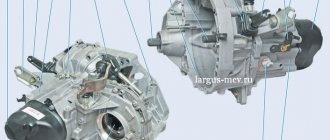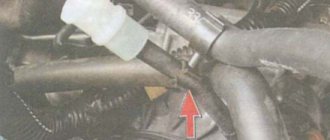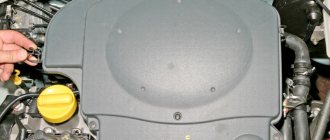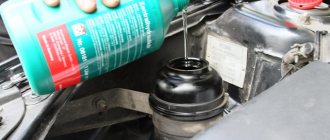The Russian station wagon LADA Largus, which first saw the light back in 2011, has since its appearance on the roads began to gain enviable popularity and expand its circle of fans. This was facilitated by the optimal set of technical and consumer qualities of this car, the list of which included: reliability, moderate cost, spaciousness and balanced equipment.
Over time, some annoying shortcomings appeared in the technical stuffing. This number can easily include the fifth-stage gear in a manual transmission; the 5th gear gear often needs to be replaced. It annoys the owner with noise, which is especially annoying on long trips.
Next, we will try to figure out how to replace the 5th gear gear.
Which 5th gear gear is better to choose?
The table shows the car speed values at different gear ratios of Largus 5th gear, as well as the article number of the driven and driving gears:
| Gear ratio 5th gear | Catalog number 1 | Catalog number 2 | Speed at 3000 rpm | Main couple |
| 0,892 | 8200611295 | 8200608035 | 93,6 | 4,214 |
| 87,6 | 4,5 | |||
| 80,0 | 4,928 | |||
| 0,820 | 8200611299 | 8200607980 | 101,8 | 4,214 |
| 95,3 | 4,5 | |||
| 87,0 | 4,928 | |||
| 0,795 | 8200611297 | 8200607978 | 105,0 | 4,214 |
| 98,3 | 4,5 | |||
| 89,8 | 4,928 | |||
| 0,756 | 8200611301 | 8200607981 | 110,4 | 4,214 |
| 103,4 | 4,5 | |||
| 94,4 | 4,928 | |||
| 0,738 | 8200611303 | 8200607983 | 113,1 | 4,214 |
| 105,9 | 4,5 | |||
| 96,7 | 4,928 |
THREE FROM THE CASTER
Editorial "Largus" tried on three pairs of gears with different gear ratios. In addition to the standard fifth gear of 0.892, we sequentially installed sets of 0.820 and 0.795 (see table). On a 300-kilometer test route, including highways and suburban roads, they compared the difference in fuel consumption and accumulated subjective assessments, which are sometimes even more interesting for the car owner than measurement data. For reliability, the expert assessment was supported by measurements at the Dmitrovsky test site. Test results and comments are presented below, including photographs, tables and diagrams.
0,892. The basic version provides excellent elasticity. Fifth gear can be used from 50 km/h even when fully loaded. You rarely have to shift down - the traction reserve is enough even for quick overtaking. But the noise of the engine operating at high speeds is annoying, even if you are moving no faster than the permitted 90 km/h: on long trips you quickly get tired.
Summary. The basic version is good for those who move mainly around the city, often with a full load
0,820. The engine is no longer perceived as so elastic, but still within normal limits. You only have to shift to fourth gear for quick accelerations. Even with a full load and in fifth gear, the car easily overcomes climbs, and on horizontal sections it confidently picks up speed from 60 km/h. At the same time, it became significantly quieter at high speeds. The gain on fuel is insignificant.
Summary . A universal option for every day. Fifth gear is quite functional in the city, and driving on the highway has become more comfortable. We recommend that AVTOVAZ take this option as the base one.
0.795. My personal choice . Editorial "Largus" is rarely fully loaded, and on country routes I usually drive on roads with flat terrain. The number of shifts from fifth to fourth on the test route increased, but only slightly. When upshifting, I stayed in fourth gear a little longer before engaging fifth, and when overtaking, on the contrary, I began to shift from fifth to fourth more often.
Summary. Optimal for suburban highways, tolerable for trips around the city. If you load your car to capacity or drive on roads with long, steep climbs or frequent overtaking, choose the 0.82 option.
0.756 and 0.738 . We have not tested these options, but judging by our impressions of the 0.795 fifth gear box, they accumulate the shortcomings of the previous option. Elasticity will deteriorate, you will have to shift from fifth to fourth more often, and there will be a significant gap between these gears.
Summary . These options are convenient, for example, for driving on a flat and empty highway at a constant speed and rarely overtaking.
Design of 5-speed manual Lada Largus
Structurally, both manual transmissions on the Lada Largus are similar. They are based on a two-shaft design with synchronizers on all forward gears. This arrangement assumes the presence of two parallel shafts - driving and driven. When the vehicle is moving and the gear is changed from the input shaft gear, torque is transmitted to a specific gear on the driven shaft.
JH3 gearbox:
- the gears are switched on and off thanks to a clutch moving along a guide sleeve with a bearing;
- the gearbox is controlled by rigid traction;
- other gear ratios (1st gear – 3.72, 2nd gear – 2.04, 3rd gear – 1.39, 4th gear – 1.02, 5th gear – 0.79).
JR5 gearbox:
- The gearbox clutch is engaged and disengaged using a hydraulic slave cylinder;
- the gearbox is controlled by two flexible cables;
- other gear ratios (1st gear – 3.73, 2nd gear – 2.05, 3rd gear – 1.32, 4th gear – 0.97, 5th gear – 0.82).
The main advantage of the car's 5-speed manual transmission is its compactness. The housing of the unit is made of aluminum, inside of which there are shafts with a set of working gears. In order to ensure the best performance of the shafts, they were equipped with synchronization rings. The design also includes: a crankcase, a speed sensor, a control lever, a gear shift mechanism and other parts that are an integral part of a traditional manual transmission.
New Lada: Kalina with E-gas, is it possible to get away from clutch and brake sensors
Manual gearboxes Lada Largus
From the very beginning of production, the car was equipped with a manual transmission-5. The transmission ensures optimal transmission of torque from the engine to the drive wheels. Depending on the power and torque of the engine, the Lada Largus is equipped with either a JH3 540 manual transmission or a similar JR5 unit. The first type of manual transmission is designed for a 5-seater station wagon with a K7M engine under the hood. There are several versions of the JR5 mechanics:
- JR5551 – for a car with a 7-seater body and a K7M engine;
- JR5549 – for the version with a 5- and 7-seater body and with a K4M engine;
- JR5517 – for van with K4M and K7M engine.
The operating principle of the above units is almost identical and consists in connecting gears with different numbers of teeth. The main task is to ensure a change in torque in strict proportion to the gear ratio. There are several levels of boost for Lada Largus engines:
Reliability jh3
The JH3 gearbox is considered a reliable unit, therefore it is still relevant in the automotive market. Car owners prefer cars with a structurally simple gearbox, partly because of its accessible and cheap maintenance. The disadvantages of manual transmission boil down to the lack of a high level of driving comfort.
The gear shift does not always occur clearly and quickly; sometimes there are jolts and jerking of the vehicle. Structurally, the unit has been fully studied, so even in the event of a serious breakdown, its overhaul will not be difficult. Usually the lever for switching from one speed to another becomes loose ahead of time, which leads to unclear switching.
Often, owners of Lada Largus with JH3 note the noisy operation of the manual transmission and a crunching sound when engaging reverse mode. Early wear of the synchronizers cannot be ruled out. If we close our eyes to some shortcomings, we will get decent mechanics that can go 200-300 thousand km without a single repair. There are known examples of cars that have covered about 500 thousand km on JH3 without a single repair. Much depends on your driving style and quality of service. The oil change must be carried out in accordance with the maintenance regulations.
New Lada: The dashboard of the Lada Kalina is blinking
Largus gearbox oil: partial and complete replacement
Let's start with the fact that the manufacturer indicates in the manual that there is no need to change the oil in the Lada Largus gearbox, that is, the gearbox is considered maintenance-free. In other words, it is filled with lubricant for the entire service life of the vehicle, and changing the transmission oil may only be necessary if the gearbox is repaired.
In practice, the situation is somewhat different, since any lubricants have their own service life. In parallel with this, gearbox wear products accumulate in the oil. This means that the oil in a fully functional gearbox needs to be changed earlier to protect the unit from wear.
Taking into account the recommendations of specialists and experienced car enthusiasts, it is optimal to replace every 60-80 thousand km. If the car is constantly used in difficult conditions, then changing the oil in the gearbox may be necessary after 50 thousand km. mileage
So, on the Lada Largus, Elf 75W80 Tranself TRJ oil is poured into the gearbox from the factory. As for the level and condition of the transmission oil, it is optimal to perform checks every 15-20 thousand km. In this case, in the case of topping up, you need to use only the oil that is already poured into the gearbox.
This means that even if a lubricant with similar properties was selected, an undesirable reaction may occur between the additive packages, which will lead to a significant deterioration or loss of useful properties of the entire volume of lubricant.
If a complete replacement is performed, the old lubricant must first be drained, after which transmission oil is poured in, which meets all manufacturer’s tolerances.
Let's move on to checking the oil level in the Lada Largus gearbox and adding lubricant to the gearbox if necessary. To check the level and add oil to the box, you need to prepare: a syringe, a container, a wrench with a square head of 8, suitable oil.
The necessary syringe can be purchased at an auto parts store. At the same time, the kit includes a rubber hose that allows you to reach the filler holes.
- To check the level, first you need to remove the engine protection, after which you need to unscrew the gearbox filler plug with a key. In this case, before unscrewing the plug, you should place a container so that the oil does not spill on the floor.
- Normally, the oil level in the gearbox should be slightly below the edge of the filler hole. If there is not enough oil, it needs to be added. To do this, you need to insert a syringe filled with lubricant into the filler neck.
- The liquid is added until it begins to flow out through the control hole. In this case, you need to wait until the oil stops leaking. Only after this can you tighten the plug, after wiping the place where it is installed with a clean rag.
- Let's also add that there is an O-ring on the plug. If its condition or integrity is in doubt, then it is better to replace such a ring immediately. Otherwise, oil may leak from under the plug.
If there is a need to completely change the oil in the Largus gearbox, the procedure will require similar tools and actions as with regular topping up. In terms of filling volume, about 3 liters of gear oil will be required.
It is also advisable to keep a small reserve, since there is a possibility that during further operation it may be necessary to add oil to the box.
Please note that the box can fit less than 3L. oil, since certain residues of old lubricant remain in the cavities of the box
You should also pour fresh oil into the filler hole slowly and gradually.
Once lubricant begins to flow out of the inspection hole, we can assume that the box is completely filled with transmission fluid. In this case, you need to tighten the plug, after which it is advisable to start the internal combustion engine and at idle speed with the clutch depressed, you should engage different gears of the manual transmission.
This will allow the oil to be distributed throughout the gearbox. In some cases, after this procedure, the engine is turned off, after which the lubricant level in the gearbox is checked again.
Reliability jr5
It’s difficult to praise the mechanical JR5 in any way, but there’s nothing particularly to reproach either. The unit itself is structurally simple, often hums, and the clarity of gear shifting leaves much to be desired. Over time, it requires overhaul or, in severe cases, replacement due to the destruction of key mechanisms. Often, car owners have to disassemble the box because the 5th speed refuses to turn off.
A roller bearing with a plastic cage on the secondary shaft is another weak point of the JR5 mechanics. The separator often falls apart even at short mileage, which leads to balls clumping together. At a minimum, the manual transmission starts to hum, but there have been cases when balls got caught between the gears. The deficiency was eliminated after the JR5 modernization.
Many problems can be avoided if you follow the manual transmission maintenance regulations and use original oil. It is advisable to change the working material of the box every 50-60 thousand kilometers. TranselfTRJ 75W-80 is suitable for replacement. After passing 10-15 thousand km, it is necessary to take control measurements of the fluid. In general, the box is old, moderately reliable, but not perfect. With the right approach it will last a long time and can be repaired without problems.
WHAT IS GOOD?
The standard sixteen-valve box has both pros and cons. Among the advantages is the ability to provide dynamic acceleration and excellent elasticity. A car with a gross weight of nearly two tons and armed with only a 105-horsepower engine confidently stays in traffic, and in fifth gear it cheerfully picks up from 50 km/h - there is no need to shift often. On long hauls, sometimes you drive for several hours in fifth as if on automatic. It’s convenient, but you have to pay for it with increased noise and fuel consumption - and even when the speedometer needle has not even reached a hundred. Therefore, together with the specialists from our technical center, we decided to experiment with different gear ratios. After all, the design of the Largus transmission allows you to change fifth gear gears without disassembling the entire box or even removing the unit from the car. By the way, owners of Renault models (for example, Logan or Sandero), as well as Nissan-Almera, can similarly configure the top gear for themselves.
There are different sets of gears on sale, each of which will cost about 3,000 rubles. The craftsman will charge the same amount for a replacement. The beauty is that you won’t have to part with the car for a long time: a competent repairman can handle it in a couple of hours. Let's try!











